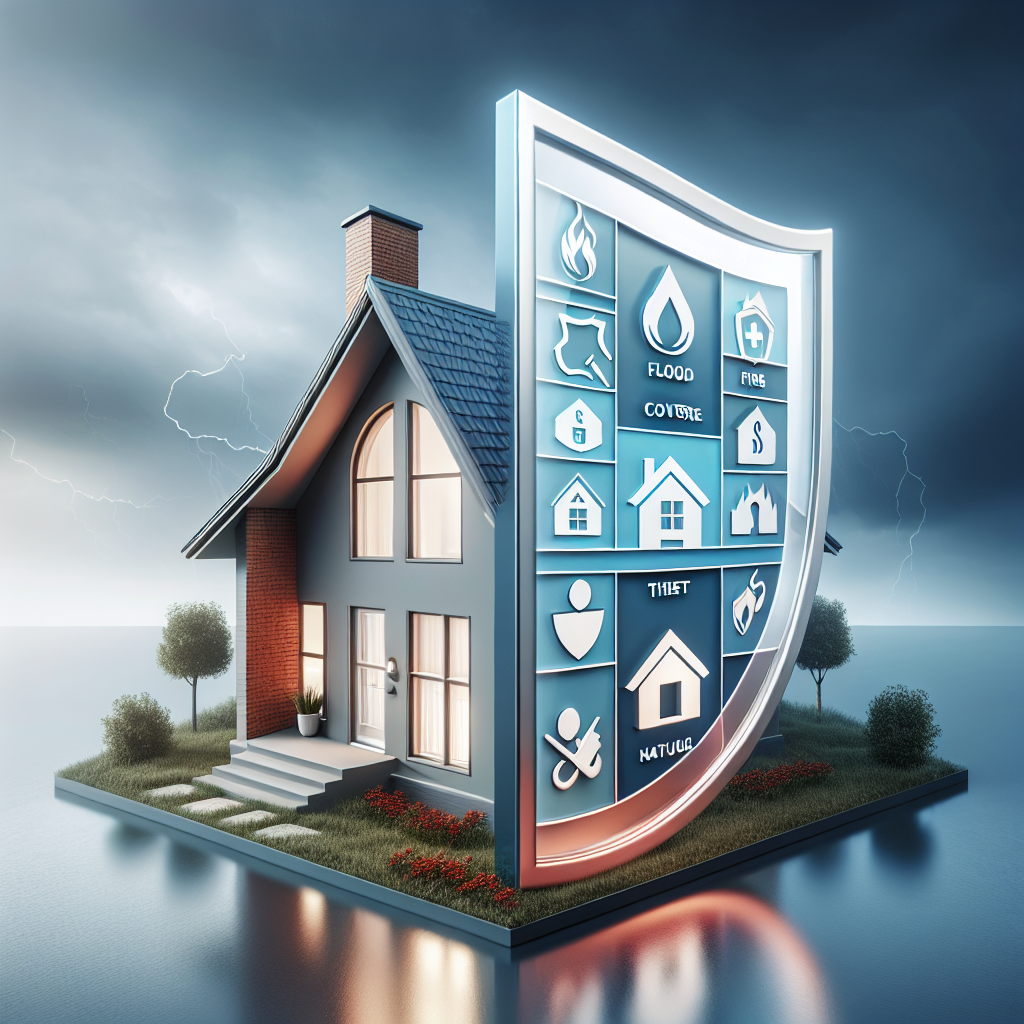Filed under Home Insurance on
Home Insurance Coverage Breakdown: What You Need to Know

If you own a home, your insurance policy is one of the few documents you hope to never use—but absolutely need to understand. Rates are changing, coverage is evolving, and exclusions matter more than ever. Consider this your practical Home Insurance Coverage Breakdown: What You Need to Know, written to help you make confident decisions, compare policies the smart way, and avoid expensive surprises at claim time.
Why Home Insurance Is Changing—and Why It Matters
Home insurance isn’t static. Carriers adjust prices and coverage based on catastrophe risk, inflation, and reinsurance costs. Over the past few years, more frequent and severe weather events have driven record losses, prompting insurers to raise rates, alter deductibles, or even pause new policies in certain regions. Construction costs also spiked, meaning many homeowners are underinsured without realizing it.
Industry groups like the Insurance Information Institute have highlighted three persistent drivers: higher rebuild costs, climate-related catastrophe losses, and the cost of capital for insurers. Add in localized issues—like wildfire exposure in the West or wind and hail in the Midwest and Southeast—and it’s clear why an accurate, current Home Insurance Coverage Breakdown: What You Need to Know can directly impact your wallet.
The Standard Policy at a Glance
Most homeowners carry an HO-3 policy, which provides broad coverage for your home and more limited coverage for your belongings. It can be customized with endorsements and higher limits.
Core Coverages (A through F)
- Dwelling (Coverage A): Pays to repair or rebuild your home if it’s damaged by covered perils. This limit should reflect full reconstruction cost, not market value.
- Other Structures (Coverage B): Detached items like fences, sheds, and detached garages—typically 10% of the dwelling limit, adjustable if you have more structures.
- Personal Property (Coverage C): Your stuff—furniture, electronics, clothing—usually at 50–70% of the dwelling limit. Off-premises theft is often covered at a reduced percentage.
- Loss of Use (Coverage D): Also called Additional Living Expense. Pays for temporary housing, meals, and other costs when your home is uninhabitable due to a covered loss. Often 20–30% of the dwelling limit.
- Personal Liability (Coverage E): Protects you if you’re legally responsible for injury or property damage to others. Common limits are $300,000–$500,000; higher is often wise.
- Medical Payments to Others (Coverage F): Small medical bills for guests hurt at your home, regardless of fault. Typical limits: $1,000–$5,000.
Named Perils vs. Open Perils
An HO-3 usually covers your dwelling on an “open perils” basis (anything not excluded is covered) and personal property on a “named perils” basis (only specific causes like fire, theft, and vandalism are covered). You can often upgrade belongings to open perils with an endorsement—useful for water damage scenarios and oddball losses that don’t neatly fit into named-peril lists.
Common Exclusions
- Flood (rising surface water): Requires a separate policy (NFIP or private flood).
- Earthquake/earth movement: Typically excluded; can be added via separate policy or endorsement in some states.
- Sewer or drain backup: Often excluded unless you add a water backup endorsement.
- Wear and tear, maintenance issues, mold beyond small sublimits, pest damage.
- Power failure originating off premises, unless caused by a covered peril.
- Intentional loss and neglect.
Understanding these boundaries is central to any Home Insurance Coverage Breakdown: What You Need to Know because exclusions are where claim disputes often begin.
How Much Coverage Do You Really Need?
Setting proper limits takes a bit of math and realism. Aim for “sleep-at-night” certainty rather than bare-minimum compliance with your mortgage lender.
Dialing in Your Dwelling Limit
Rebuild costs include labor, materials, debris removal, architect fees, and code upgrades. Use a replacement cost estimator through your agent, then validate with local contractors. Many carriers offer extended or guaranteed replacement cost endorsements that add 25–50% or even unlimited coverage above your limit; this safety net is invaluable during post-disaster cost spikes.
Don’t peg your limit to purchase price or property tax value. Those figures reflect land, neighborhood desirability, and market conditions—not the cost to rebuild.
Personal Property: Sublimits That Trip People Up
While personal property has a broad limit, high-value categories have hidden caps—think jewelry, watches, firearms, silverware, collectibles, cash, and certain electronics. Theft of jewelry might be limited to a few thousand dollars unless you schedule items with appraisals. If you own specialized gear—musical instruments, camera equipment, sports memorabilia—consider itemizing them with agreed values.
Liability and Medical Payments
Liability is inexpensive relative to the protection it provides. If you have a pool, trampoline, dog, or frequently host gatherings, raising liability to $500,000 and adding a $1–$2 million umbrella policy is prudent. Medical payments to others is a goodwill coverage that can prevent minor incidents from escalating.
Loss of Use: The Silent Budget Saver
After a major loss, temporary housing costs can balloon. Check that loss of use is at least 20–30% of your dwelling limit, and confirm how long benefits last. Keep receipts; insurers reimburse actual expenses above your normal living costs.
Replacement Cost vs. Actual Cash Value
These settlement methods can change your claim outcome by thousands.
- Replacement Cost (RCV): Pays what it costs to repair or replace without depreciation. Often paid in two steps—first ACV, then the withheld depreciation after you complete repairs within the policy’s timeframe.
- Actual Cash Value (ACV): Replacement cost minus depreciation. Cheaper premiums, smaller checks, especially for older roofs and worn property.
Many policies now pay ACV for roofs damaged by wind or hail if the roof is older, unless you add a roof replacement cost endorsement. Watch for cosmetic damage exclusions on metal roofs; they can deny coverage if dents don’t impair function. Clarify “matching” provisions: if one side of your siding is damaged, will the insurer pay to match undamaged sections for a consistent look?
Deductibles and Special Disaster Deductibles
Home policies use either a flat dollar deductible (e.g., $1,000 or $2,500) or a percentage deductible for certain perils.
- Wind/Hail or Named Storm Deductibles: Common in coastal and storm-prone regions, set as a percentage (1–5%) of your dwelling limit.
- Hurricane Deductibles: Kick in when a storm meets defined criteria (varies by state).
- Wildfire Deductibles: Emerging in high-risk fire zones; read state-specific rules.
A higher deductible can reduce premiums, but be sure you can afford it out-of-pocket. During catastrophes, percentage deductibles become significant; a 2% deductible on a $500,000 dwelling limit means you cover the first $10,000 of repair costs.
Popular Endorsements Worth Considering
- Water Backup and Sump Overflow: Covers damage from backups through sewers, drains, or sump systems—one of the most common uncovered losses without this add-on.
- Service Line Coverage: Pays to repair underground pipes and wires from the street to your home (water, sewer, power)—typically not covered otherwise.
- Equipment Breakdown: Helps when home systems (HVAC, appliances, smart home tech) fail due to mechanical or electrical breakdown.
- Ordinance or Law: Adds coverage to bring repairs up to current building codes—vital for older homes. Consider increasing to 25–50% of dwelling limit.
- Extended or Guaranteed Replacement Cost: Buffers you against cost overruns after a total loss.
- Scheduled Personal Property: Broader protection and no deductibles for high-value items like jewelry, art, or musical instruments.
- Home Business Property and Liability: If you store inventory, tools, or see clients at home, standard limits won’t be enough.
- Identity Fraud Expense: Covers recovery costs if your identity is stolen.
- Flood and Earthquake: Separate policies or endorsements depending on your location and carrier.
Adding the right endorsements transforms a basic policy into a comprehensive safety net—the essence of any thoughtful Home Insurance Coverage Breakdown: What You Need to Know.
Discounts and Ways to Control Premiums
- Bundle Home and Auto: Often the largest multi-policy discount.
- Raise Your Deductible: Weigh the savings against your emergency fund capacity.
- Roof Upgrades: Impact-resistant shingles or a FORTIFIED Roof designation can lower wind/hail premiums.
- Smart Water and Security Devices: Monitored leak detectors, automatic shutoff valves, centrally monitored alarms, and smoke detectors earn credits.
- Mitigation Credits: Wind mitigation inspections in hurricane states; defensible space and fire-hardening in wildfire zones.
- Claims-Free History: Staying claim-free for multiple years compounds discounts.
- Update Systems: Newer plumbing, electrical, and HVAC reduce risk and improve eligibility.
- Shop Strategically: Compare carriers annually, but maintain continuity if you’re in a catastrophe-prone area where insurers value tenure.
- Credit-Based Insurance Scores: In most states, better credit correlates with lower premiums. Know your state’s rules.
The Underwriting Process and Inspections
Carriers increasingly verify details with aerial imagery, exterior inspections, and smart data. Expect questions about the age of your roof, type of wiring and plumbing, distance to a fire hydrant, and the presence of risk factors like pools, trampolines, wood stoves, or certain dog breeds.
If an inspector notes peeling roof shingles, missing handrails, or leaning fences, you may receive a repair requirement. Fixing issues early avoids cancellations and keeps claims smooth. Don’t be surprised by drone photos—many carriers use them to validate roof condition and tree overhang risk.
Filing a Claim the Smart Way
- Protect the Property: Take immediate steps to stop further damage (e.g., board up, shut off water). Document your actions and keep receipts.
- Document Everything: Photos and video from multiple angles, date-stamped if possible. For theft, get a police report.
- Contact Your Carrier or Agent: File promptly and confirm your deductible, coverage, and any special conditions (like hurricane deductibles).
- Meet the Adjuster Prepared: Have estimates, your home inventory, and a list of damaged items with approximate values.
- Track Additional Living Expenses: Save receipts for temporary housing, meals, laundry, pet boarding, and extra commuting costs.
- Understand Payment Stages: You may receive ACV first, then recoverable depreciation after repairs are completed within deadlines.
- Know Your Rights: If you disagree with the estimate, request a supplemental review, consider the policy’s appraisal clause, or seek state mediation where available.
A detailed inventory before loss is invaluable. Walk each room with your phone camera once a year and store the video in the cloud. During a catastrophe, patience helps—adjusters handle heavy caseloads, and material shortages can delay repairs. A realistic Home Insurance Coverage Breakdown: What You Need to Know should prepare you for timelines as well as dollar amounts.
Condo, Renters, and Landlord Variations
Renters Insurance (HO-4)
Protects your belongings and liability but not the building. It also includes loss of use. It’s inexpensive and essential if you rent—your landlord’s policy doesn’t cover your stuff.
Condo Insurance (HO-6)
Your master association policy covers common areas and, depending on bylaws, part of your unit. Your policy covers what the master policy doesn’t (often “walls-in”), plus your belongings, loss of use, and liability. Add Loss Assessment coverage to help pay your share if the association issues a special assessment after a covered loss.
Landlord Policies (DP-3)
Designed for rental properties, these typically cover the dwelling on an open perils basis and include Fair Rental Value for lost rent after a covered loss. They exclude the tenant’s belongings; require your tenants to carry renters insurance to reduce disputes and protect your liability.
Frequently Misunderstood Scenarios
- Fallen Trees: Your policy covers damage to your property regardless of who owns the tree, unless negligence can be proven. Debris removal coverage is limited unless the tree damages a covered structure.
- Neighbor’s Water Leak: Your insurer still handles the claim for your damage; subrogation may happen behind the scenes.
- Sewer Backup: Not covered without a water backup endorsement.
- Short-Term Rentals: Home-sharing can be excluded or limited. Ask about a home-sharing endorsement or separate policy.
- Vacancy: If a home is vacant for 60 days or more, certain protections can be reduced or voided. Use a vacancy permit or proper policy type.
- Mold: Often capped at low limits unless you add an endorsement.
- Termites and Rodents: Maintenance issues—excluded.
- Food Spoilage: May be covered after a covered peril; off-premises power failure is often excluded.
- Solar Panels: Coverage varies depending on whether panels are attached or ground-mounted and who owns them (lease vs. own).
- Landscaping: Trees and plants have small sublimits; wind may be excluded while fire is typically covered.
Choosing a Carrier and Agent
- Financial Strength: Look for strong ratings from A.M. Best or similar agencies.
- Claims Satisfaction: Industry surveys and local feedback matter—speed and fairness are key.
- Coverage Breadth: Compare endorsements, limits, and settlement terms (ACV vs. RCV).
- Risk Appetite: Some carriers excel with older homes; others prefer new builds or certain regions.
- Admitted vs. Surplus Lines: Admitted carriers are backed by state guaranty funds; surplus lines offer flexibility for tough risks but with fewer consumer protections.
- Independent Agent Advantage: Can shop multiple carriers and tailor endorsements for your situation.
2025 Market Trends to Watch
Several trends are shaping premiums, underwriting, and claims handling:
- More Granular Pricing: Use of aerial imagery, roof analytics, and block-level hazard scoring to price risk and enforce eligibility rules.
- Mitigation Incentives: Bigger credits for wildfire hardening, roof upgrades, and smart water shutoffs as carriers push prevention.
- Catastrophe Deductibles and Coverage Nuance: Expect more policies with separate wind/hail or named-storm deductibles and refined definitions in declarations.
- Repair Networks and Managed Claims: Wider use of preferred contractors and digital claims tools; faster for straightforward losses, but know you can choose your contractor.
- Stabilizing but Elevated Rebuild Costs: Supply chains improved, yet labor remains tight in many markets—underscoring the value of extended replacement cost.
- Parametric Add-Ons: In some regions, small fixed payouts triggered by measured events (e.g., quake intensity) may complement traditional coverage.
Keeping up with these shifts is part of a smart Home Insurance Coverage Breakdown: What You Need to Know—because a policy that was ideal two years ago might be only average today.
Risk Reduction That Pays Off
- Water Defense: Install smart leak detectors and an automatic shutoff valve on the main line; replace aging supply lines to washers, toilets, and sinks.
- Roof and Gutter Care: Clean gutters, trim overhanging branches, and consider impact-rated shingles. Keep records for underwriting credits.
- Fire Hardening: Noncombustible roof and siding, ember-resistant vents, and a 5-foot ignition-free zone around the home in wildfire areas.
- Wind Mitigation: Upgraded roof decking, clips/straps, and quality garage doors; get a wind mitigation inspection where applicable.
- Electrical and Plumbing Updates: GFCI/AFCI protection, copper or PEX supply lines, and removal of obsolete systems (knob-and-tube wiring, polybutylene piping).
- Security: Monitored alarm systems and exterior lighting reduce theft risk and often lower premiums.
Quick Checklist Before You Buy or Renew
- Confirm your dwelling limit with a modern replacement cost estimate; add extended or guaranteed replacement cost if available.
- Upgrade personal property to replacement cost and schedule high-value items to bypass sublimits.
- Raise liability to at least $500,000 and consider an umbrella policy.
- Add water backup, service line, and ordinance or law endorsements as needed.
- Check special deductibles for wind/hail or named storms and ensure you can afford them.
- Verify loss of use duration and limits; understand documentation requirements.
- Ask about roof settlement terms, matching, and cosmetic damage language.
- Document your home inventory with photos or video; store copies off-site or in the cloud.
- Shop carriers with strong financials and solid claims reputations; compare real coverage, not just price.
- Install mitigation devices (water shutoff, alarms) and ask your agent to apply credits.
Run through this list alongside this Home Insurance Coverage Breakdown: What You Need to Know to turn renewal season into a quick, confident exercise rather than a scramble.
Real-World Examples to Sharpen Your Strategy
- Kitchen Fire: Smoke damages cabinets and appliances. With replacement cost, you’re made whole after repairs; without it, depreciation can shrink your payout dramatically.
- Hailstorm Roof Claim: Your older roof is settled at ACV unless you purchased a roof RCV endorsement. That single endorsement can mean thousands more toward replacement.
- Sump Pump Failure: Without water backup coverage, a finished basement cleanup can be entirely out-of-pocket.
- Condo Water Loss: The association’s master policy repairs drywall to studs; your HO-6 must cover interior finishes and personal property. Loss assessment helps if the HOA hits owners with a special fee.
When to Revisit Your Policy
- Major Renovations or Additions: Square footage and finish upgrades change your replacement cost.
- New Roof, Plumbing, or Electrical: Update your insurer to capture discounts and ensure accurate underwriting.
- Big Purchases: Jewelry, art, high-end electronics—schedule items promptly.
- Life Changes: Marriage, new baby, starting a home business, or short-term renting part of your home all warrant policy adjustments.
- Market Shifts: If your area faces new catastrophe risks or rapid price increases, consider carriers with stronger local appetite and mitigation credits.
The Bottom Line
Your policy is more than a premium and a deductible—it’s a blueprint for how your financial life will be protected on a terrible day. By understanding coverage types, settlement terms, exclusions, and endorsements, you can tailor a policy that fits your home and risk profile. Use this Home Insurance Coverage Breakdown: What You Need to Know as your working guide, revisit it at each renewal, and don’t hesitate to press your agent for specifics. A few targeted adjustments now can mean tens of thousands saved—and far less stress—when you need your policy most.
Before you click renew, compare your declarations page line by line against this Home Insurance Coverage Breakdown: What You Need to Know. Confirm limits, shore up weak spots, and lock in the credits you deserve. That’s how you turn insurance from a mystery into a plan.




